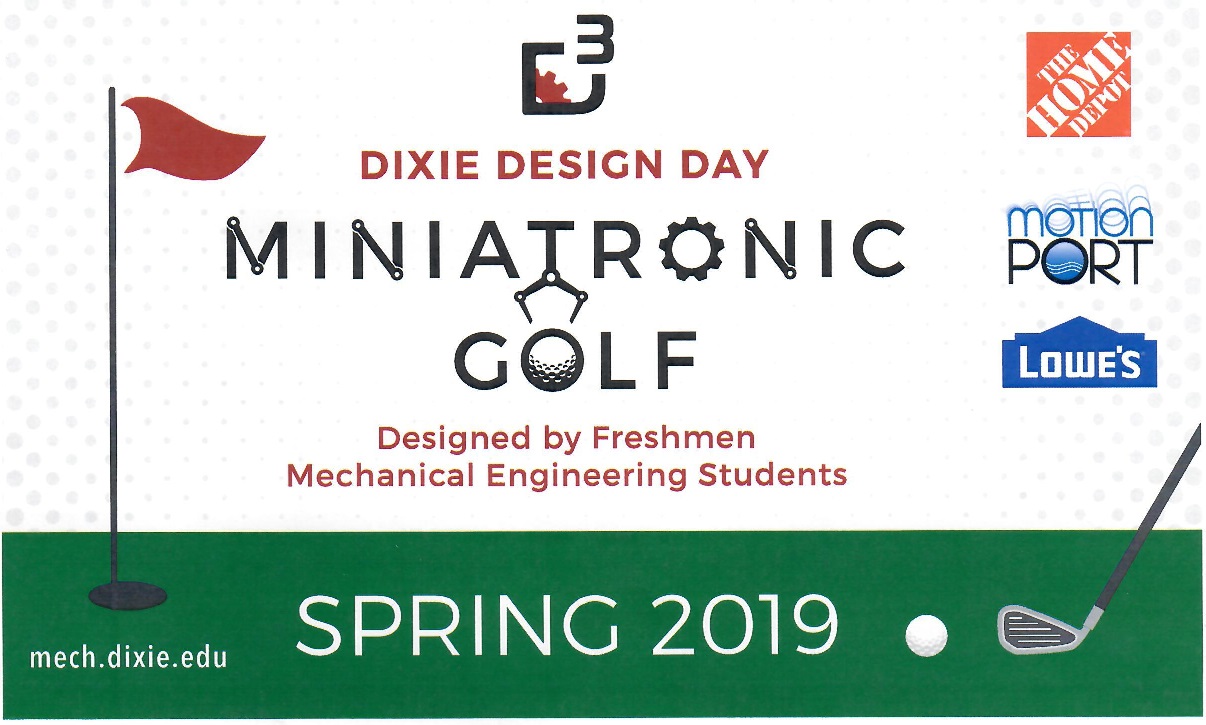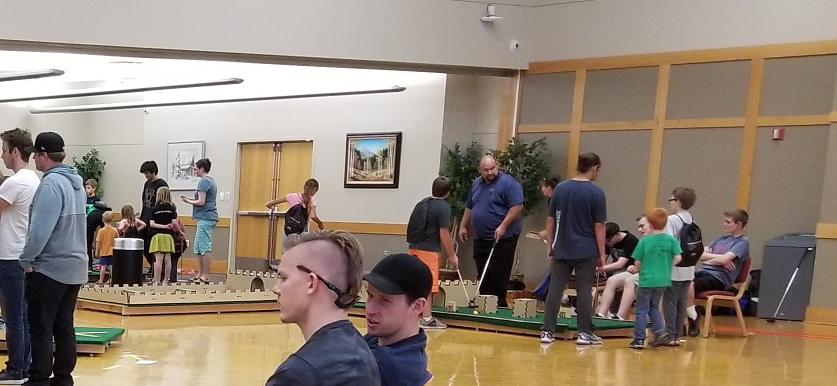MotionPort Supports Local Mechanical Engineering
Student Competition
MotionPort headquarters is located in St. George, Utah, a small town. Our small town has a university, Dixie State University, and Dixie State recently started a Mechanical Engineering program. Some of the initial set of students enrolled this semester in the Introduction to Design and Prototyping class. The final major project of the class was a design competition, held in the last week of regular classes.
These students are ending their semester in style… “Miniatronic” Golf style, as shown in the back of the player’s “scorecard” below:

In this 1st Annual Dixie Design Day, teams of 3 to 5 students were tasked with building a themed putting green that the public would be allowed to play. There were nine teams and the overall result was a 9-hole course with a par of 28. Players got a chance to golf in the jungles of the Aztec or zoom through a Futuristic world while other patrons were seen traveling Around the World or getting Lost in Space.
The students had three opportunities to impress: official judging by our own Brant Ross (sponsor judge), faculty evaluation by DSU Engineering Department professors David Christensen and Trevor Terrill, and voting by players from the community.
Final Prep
Students had been working on the final setup for their holes in the competition venue since the day before. Many stayed through the night (sound familiar?). Battling through power outages and mechanical malfunctions are all part of the experience of growth and learning in engineering and these students were taking it in stride.
Design Elements Showcased
The design elements used in the holes varied in creativity, complexity, and ultimately in reliability. Some of the systems were quite ambitious.
For example, consider the ball lifting mechanism (shown below). In operation the ramp sits in front of the mechanism and the ball holder is at the same level as the ramp. The golfer hits the ball up the ramp and into the holder. A sensor detects the ball and the holder lifts the ball to the top, where it is transferred to the black pipe and rolls down to the next section of the hole. The concept was good, but the execution had some challenges with the amount of force needed to raise up the ball holder along the track, with ultimately some issues with belt slipping. It is an interesting concept.
The “Earthquake Bridge”, also shown below, has a sensor that detects when a ball enters the bridge. At that point both belts start moving back and force to represent the low-frequency motion of an earthquake. This system was reliable.
The feature below was well thought out. The golfer needed to hit the ball though all of the loops. As each loop was completed, the corresponding bar of lights at the top of the image would light up. Once all three loops were traversed, all lights were on and a gate would lower to allow the golfer to hit the ball to the next section.
This device is simple but interesting to the golfer and totally reliable.
The “trap door” at the top of the ramp is controlled by a timer, and opens and closes with a regular interval.
When the trap door is open the ball exits the hole at the center of the base of the ramp.
When the trap door is closed the ball rolls down the other side of the ramp.
Excellent creativity was exhibited with this design element.
The golfer was instructed to hit the ball into the basin with lights that matched the color of the golf ball.
If the golfer did this correctly then the hole was finished.
If the golfer made a mistake then the ball was returned to the bottom of the section for another try.
Judging before Grand Opening
Before the public got a chance to take the course through its paces, Brant got to visit with each group to learn more about the projects and how each individual member constructed their assigned section.
Judging consisted of scoring the following categories:
- level of completion
- adhering to the assigned theme
- interactive elements
- difficulty level of play
- design creativity
- safety
- overall presentation
Given that the general public would interact with the golf holes, there were several matters that needed to be addressed other than the design of the mechatronic systems.
Safety judging mainly consisted of making sure that the golfer could not hit the ball past that hole boundaries. Generally the walls of the hole were sufficiently high, but in some cases low boundaries were used. That resulted in a deduction.
Another judging area was to determine if there was enough signage to instruct the golfers how to address the obstacles in the hole. It is good for engineering students to learn early in their education that the best product in the world has limited value if the customer struggles to learn how to use it.
Brant reported that he really enjoyed seeing the creativity that the students brought to their work.
For example, one of the holes featured a pneumatic hazard. When the golfer approached a location that was being defended, a sensor detected the golfer’s foot and shot a blast of air in that direction.
Creative and fun!
(Click an image for a larger view.)
Bring in the Crowds!
After the judging was over, the public was allowed to participate in a round of putt-putt golf. In attendance were college students, faculty, and staff; as well as families and friends from the community.
Dixie Design Day staff members did a great job keeping the game of play moving along, even when it was so busy that there were a few lines forming for holes and even patrons waiting for the next golf ball to become available (given a supply of 60 balls!).
Once they finished their game, golfers were asked to vote for their favorite hole.
This was a great experience for the freshman students. Although portions of their project did not work as planned, many things were working. Most importantly, all of the students learned a lot.
We can have high hopes that the senior design projects that these same students will be doing in three years will be really amazing, and will have their roots in this event.
All in all, DSU’s first Dixie Design Day was a real “hole-in-one”!















